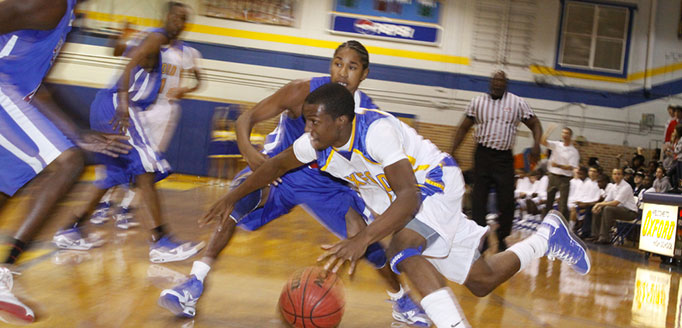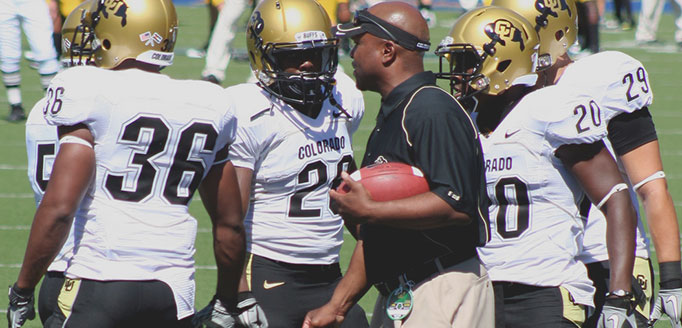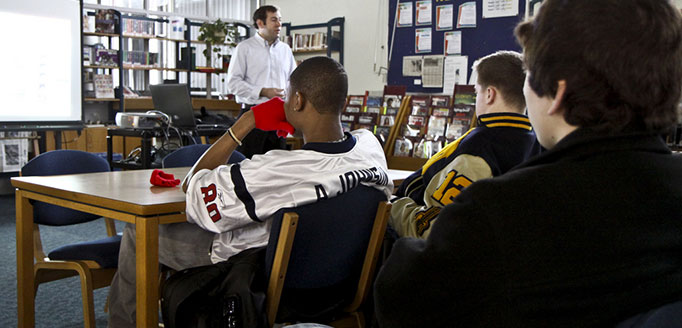50 Critical Tips for Landing an NCAA Scholarship
So you want to be a college sports star? If you’ve got the goods, an athletic scholarship can be the ticket (or at least part of a ticket) to a fantastic education. Since you’re reading this article, we’ll assume you’re not the next Cam Newton. You’re a solid lineman or shooting guard or golfer who doesn’t have coaches beating down his door. While the odds of landing a scholarship to an NCAA program are not in your favor, these 50 tips will give you a fighting chance of being paid to play.
Personal development
- Adjust your expectations:Rule No. 1 is to realize that if you’re “very lucky,” you’ll receive a scholarship offer that covers 15% of your college costs. Full rides are astoundingly rare and even they do not cover living expenses.
- Be versatile:In sports like track or baseball, if you can prove to recruiters an ability to excel in a variety of events or positions, you up your chances of earning a scholarship (and the amount of dollars that scholarship entails).
- Practice:Obviously you need to keep up your skills by practicing and staying in peak condition, but you’ll be expected to practice at least 20 hours a week when you get to college on that scholarship. So you’d better be prepared to balance that with school.
- Read:There are some great books on the subject, for both parents and athletes. Buying two or three would be well worth the investment if the advice in them pays off.
- Don’t be discouraged if you’re not the best:You don’t even have to make the college team to win some athletic scholarships; all it takes is a commitment to play, whether in intramurals or club teams.
- Build your character:Don’t overlook the fact that coaches take into account an athlete’s work ethic, ability to play with a team, and level of respect for authority.
- Strength train:Many young athletes focus too much on camps or tournaments and let their strength training suffer. Strength training helps prevent injury and increases athleticism, both huge factors in scholarship determination.
- Don’t limit yourself to D-I:Getting a Division-I athletic scholarship is extremely hard. Though it’s not as high profile, in Division-II there is significant athletic scholarship money to be had.
- Learn how to network:Never ignore a chance to make a contact with a coach or a school official. It never hurts to have friends helping you promote yourself.
- Be prepared for your meeting:Just as in a job interview, if you can display a knowledge of a team’s recent history and an understanding of their culture, coaches will be more inclined to view you as a fit.
- Know the rules:As you may have heard, the NCAA can be a tricky bureaucracy to keep happy. Make sure you learn all its rules for scholarship eligibility so you don’t accidentally disqualify yourself.
- Don’t depend on your parents:Coaches tolerate parents, but they really want to deal with you, the player. In high school, start taking the responsibility of dealing with your coach yourself so that you build the maturity college coaches want to see.
- Quiz yourself:Asking yourself why you love the game and why you’re interested in a particular school prepares you to answer those questions when they come from a prospective coach, and they’re also good reminders to keep at it.
- Eat right:It’s amazing how even professional athletes can ignore the fact that the fuel you put in your body will determine how well it runs. Give yourself one more athletic advantage by eating healthy.
- Stay out of trouble:Rest assured: a sure-fire way to void a verbal offer or keep anyone from offering you one is to get in trouble at school or with the law.
- Get adjusted:Many pro athletes swear by chiropractors to stay in tip-top shape. Regular visits to a sports chiropractor might make you the little bit faster or more flexible that you need to impress a coach.
Interacting with coaches
- Contact them first:Don’t wait for them to come to you. Emailing coaches, calling them, or sending them your highlight reel are perfectly acceptable ways of generating some heat for yourself.
- And stay in contact:Don’t become a thorn in a coach’s side, but keep in touch with him or her to prove your maintained interest in that school and in case another athlete declines a scholarship and one opens up.
- Let them know your schedule:In your communications, make coaches aware of your upcoming matches by providing the times and dates you can be seen competing.
- Don’t rely too much on email:The value of a face-to-face meeting is often understated. Visiting schools shows coaches initiative and a high level of interest.
- Don’t show up unannounced:“Unofficial” on-campus visits are great, but it’s key to clear it with the coaching staff before you drop by the offices or a practice unannounced.
- Class up your email address:Coaches are just people, and they might wonder about your maturity level if your email address is thefootballkinggg22@hotmail.com. Also make sure your voicemail recording is appropriate.
- Use a networking service:There are a number of free and paid online services like beRecruited.com and ActiveRecruiting.com that help you create a profile that connects you with coaches all over the country.
- Exercise caution:Use your best judgment to determine if a coach has your best interests at heart or is apt to tell you what you want to hear and then disappear with your scholarship offer. A good test is whether the coach values academics or just pays it lip service.
- Fill out school’s online questionnaires:Many colleges host online forms you can fill out to register your desire for them to recruit you. Be sure you meet all their requirements before you submit them.
- Don’t bank on verbal offers:One of the ugly sides of athletic recruiting is verbal offers and the fact that they are often rescinded. Know that nothing is official until you sign a letter of intent.
- Leverage offers:If you contact enough schools you may be lucky enough to get multiple offers. Don’t be afraid to use an offer from one school to entice another school to up their offer.
- Get letters of recommendation:Two or three endorsements from your high school coach and club coaches are good to include in your portfolio materials. Ask them to describe your work ethic and what kind of potential they see in you.
- Don’t be on the lookout for a four-year “full ride” scholarship:College athletic scholarships are good for one year and one year only. They have to be renewed every year. Absolutely don’t turn down an offer because it’s “only” for one year.
- Include a cover letter:In a maximum of half a page, help coaches get a feel for who you are and what you would contribute to a team by including a cover letter in your mail-outs.
- Be prompt in responding:Not only does taking days to respond to a call or email from a coach reflect poorly on your character, coaches won’t wait around forever to give their precious time to someone else.
- Don’t “cc” multiple coaches:Carbon copying is also known by an uglier name: spamming. Nobody likes it, including coaches. Send each one a personalized email.
- Know what constitutes interest:Because of NCAA regulations, coaches can’t send you recruiting materials before your junior year. If they’re interested, however, they can send you general college info or questionnaires. See these as implied interest in recruiting you.
- Follow programs on social media:Most athletic programs and some coaches have an online presence either on Twitter or Facebook or both. Following them is a great way to get a feel for them. (And speaking of Twitter, watch what you say.)
- Post on YouTube:Many coaches prefer online videos to DVDs, as they’re easier to access and require no storage space. Instead of trying to make 300 copies of a highlight reel, consider loading it to YouTube and including the URL in your mail-outs.
- Set goals:Keep your ear to the ground about what times in the 40, what batting average, or whatever stats apply to your sport coaches are looking for. Make these your personal goals in your training.
High school chores
- Start early:The time to begin working on landing a scholarship is not the summer before you head to college. In your sophomore or even freshman year of high school you should start thinking about what sport offers you your best chance.
- Take the SAT in sophomore year:This comes straight from the mouth of an actual coach. Taking the SAT early to see what you need to improve on helps you get a good score later, without which some schools will cease to even consider you for an athletic scholarship.
- Build your portfolio:As soon as you make varsity, begin building a portfolio of your athletic accomplishments by collecting newspaper clippings and/or creating a video highlight reel of your best plays.
- Make an efficient highlight reel:You don’t need a professional videographer to make your highlight video, but you do want it to be good quality video, relatively short, and with no music or fancy transitions. You also need some way of delineating yourself in the video, like an arrow or circle.
- Ensure you’re on coaches’ recruiting lists:On Sept. 1 of your junior year of high school NCAA coaches are allowed to begin contacting you. If you don’t have anything from anyone by winter break, you need to take action to get on their radars.
- Don’t rely on your high school coach:Most likely, your current coach is also a teacher, which means he or she is extremely busy. Don’t put the burden on him or her to do all your marketing for you.
- …But don’t ignore him, either:Your coach can be a great resource for answers to questions about possible programs that would be a good fit for you, given your abilities and preferences.
- Keep your grades up:Don’t muddy the water by barely scraping by in class. Colleges do have minimum GPA requirements, and if yours is too low, you give coaches a reason to pass you over.
- Apply to the school:You still have to apply to the school and be accepted like everyone else. Doing so early proves to prospective coaches your seriousness in attending there.
- Go to camps:For football players especially, you need to be attending camps and combines to keep your skills up and possibly to display them in front of coaches and scouts.
- Stay healthy:It might be worth it to ask yourself if that senior year Spring Break skiing trip is really worth the risk of a broken leg and a rescinded scholarship offer.
- Earn a varsity starting spot:Put in as much time and effort as it takes to be one of your high school’s top players, because the talent pool you’re about to enter will be a whole lot bigger.
- Register with the NCAA Eligibility Center:Before you can receive a scholarship, you have to prove your amateur status with the NCAA. The Association recommends you do this at the start of your junior year of high school.
- Do your homework:Don’t waste time or resources trying to win a scholarship to a school with no open spots for your position. Research to find which teams have a need for someone like you.










